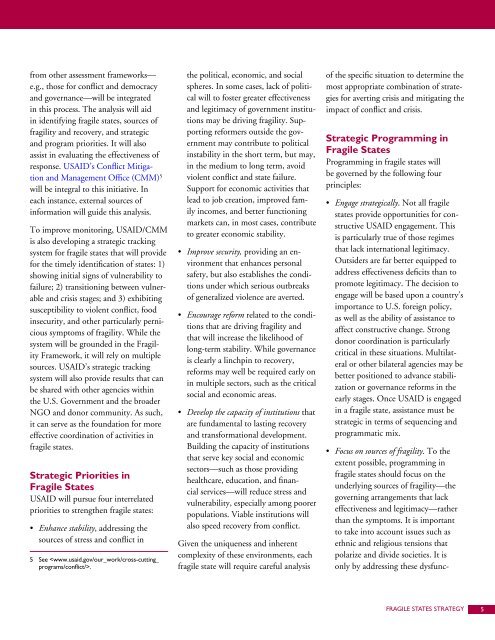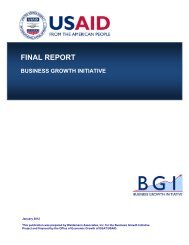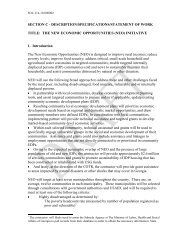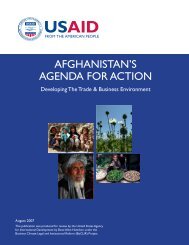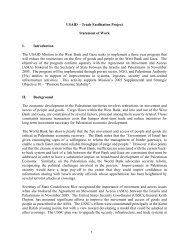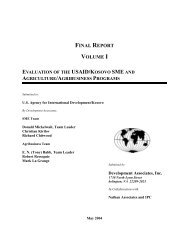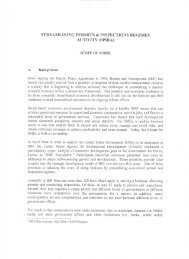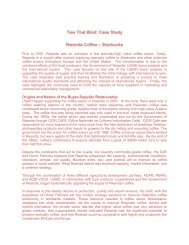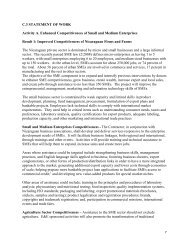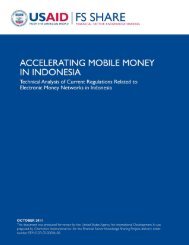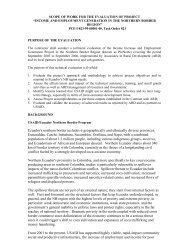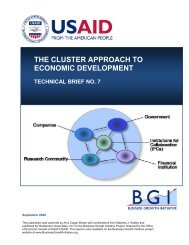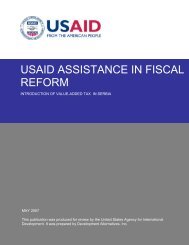USAID Fragile States Strategy - The Air University
USAID Fragile States Strategy - The Air University
USAID Fragile States Strategy - The Air University
- No tags were found...
You also want an ePaper? Increase the reach of your titles
YUMPU automatically turns print PDFs into web optimized ePapers that Google loves.
from other assessment frameworks—e.g., those for conflict and democracyand governance—will be integratedin this process. <strong>The</strong> analysis will aidin identifying fragile states, sources offragility and recovery, and strategicand program priorities. It will alsoassist in evaluating the effectiveness ofresponse. <strong>USAID</strong>’s Conflict Mitigationand Management Office (CMM) 5will be integral to this initiative. Ineach instance, external sources ofinformation will guide this analysis.To improve monitoring, <strong>USAID</strong>/CMMis also developing a strategic trackingsystem for fragile states that will providefor the timely identification of states: 1)showing initial signs of vulnerability tofailure; 2) transitioning between vulnerableand crisis stages; and 3) exhibitingsusceptibility to violent conflict, foodinsecurity, and other particularly pernicioussymptoms of fragility. While thesystem will be grounded in the FragilityFramework, it will rely on multiplesources. <strong>USAID</strong>’s strategic trackingsystem will also provide results that canbe shared with other agencies withinthe U.S. Government and the broaderNGO and donor community. As such,it can serve as the foundation for moreeffective coordination of activities infragile states.Strategic Priorities in<strong>Fragile</strong> <strong>States</strong><strong>USAID</strong> will pursue four interrelatedpriorities to strengthen fragile states:• Enhance stability, addressing thesources of stress and conflict in5 See .the political, economic, and socialspheres. In some cases, lack of politicalwill to foster greater effectivenessand legitimacy of government institutionsmay be driving fragility. Supportingreformers outside the governmentmay contribute to politicalinstability in the short term, but may,in the medium to long term, avoidviolent conflict and state failure.Support for economic activities thatlead to job creation, improved familyincomes, and better functioningmarkets can, in most cases, contributeto greater economic stability.• Improve security, providing an environmentthat enhances personalsafety, but also establishes the conditionsunder which serious outbreaksof generalized violence are averted.• Encourage reform related to the conditionsthat are driving fragility andthat will increase the likelihood oflong-term stability. While governanceis clearly a linchpin to recovery,reforms may well be required early onin multiple sectors, such as the criticalsocial and economic areas.• Develop the capacity of institutions thatare fundamental to lasting recoveryand transformational development.Building the capacity of institutionsthat serve key social and economicsectors—such as those providinghealthcare, education, and financialservices—will reduce stress andvulnerability, especially among poorerpopulations. Viable institutions willalso speed recovery from conflict.Given the uniqueness and inherentcomplexity of these environments, eachfragile state will require careful analysisof the specific situation to determine themost appropriate combination of strategiesfor averting crisis and mitigating theimpact of conflict and crisis.Strategic Programming in<strong>Fragile</strong> <strong>States</strong>Programming in fragile states willbe governed by the following fourprinciples:• Engage strategically. Not all fragilestates provide opportunities for constructive<strong>USAID</strong> engagement. Thisis particularly true of those regimesthat lack international legitimacy.Outsiders are far better equipped toaddress effectiveness deficits than topromote legitimacy. <strong>The</strong> decision toengage will be based upon a country’simportance to U.S. foreign policy,as well as the ability of assistance toaffect constructive change. Strongdonor coordination is particularlycritical in these situations. Multilateralor other bilateral agencies may bebetter positioned to advance stabilizationor governance reforms in theearly stages. Once <strong>USAID</strong> is engagedin a fragile state, assistance must bestrategic in terms of sequencing andprogrammatic mix.• Focus on sources of fragility. To theextent possible, programming infragile states should focus on theunderlying sources of fragility—thegoverning arrangements that lackeffectiveness and legitimacy—ratherthan the symptoms. It is importantto take into account issues such asethnic and religious tensions thatpolarize and divide societies. It isonly by addressing these dysfunc-FRAGILE STATES STRATEGY 5


